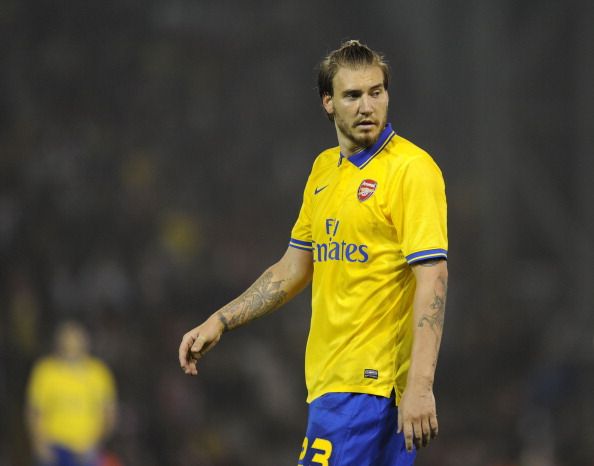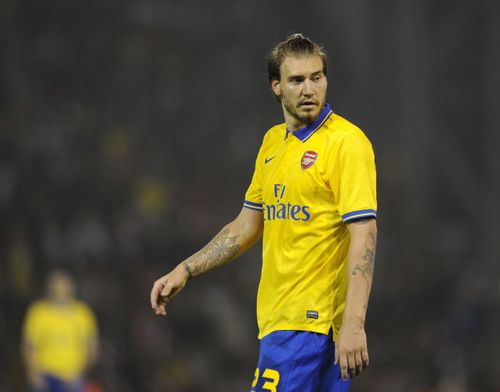
Arteta’s style a liability now, Bendtner’s introduction could change Arsenal’s long ball patterns

Arsenal ended the 120 minutes of play on Wednesday with five 18 year olds in midfield, a striker without a goal in the last 2 years, but more crucially with a steadfast and experienced defence. Though the result finally turned out to be an outcome of a lottery, the entire game on the whole turned out to be an eye opener in terms of the bench strength for the rest of the season.
Thomas Vermaelen was supposed to have a tough night against the strength and pace of Shane Long, and the Belgian dutifully obliged by always being a yard behind the Irish striker in every tackle and long ball. What normally seems to be an easy ball for Koscienly to defend against or an expected tackle for the French defender to make, seemed to be a huge task for Arsenal’s captain on the night. And if not for Per Mertersacker in the back, Vermaelen’s weak attempts at playing the ball out of defence would have cost the team. This again is the reason why Koscienly and Vermaelen, 2 ball-players, can’t be fielded together.
A lot was said about Arteta’s return to this Arsenal squad in the midst of some good performances by the central midfielders. On Wednesday night, the Spaniard was paired with the defence-minded Issac Hayden and this allowed Eisfeld the freedom to roam front in attack. But this is where the inexperience of the young German came up as he rarely ventured ahead and rather formed a flat mid 3 with Arteta. So it was often Arteta who needed to push up from midfield to bring the ball to Bendtner and co.
Apart from Hayden’s rough tackle in the first half, it was the dynamic attacking trio of West Brom that caused Wenger worries. Scott Sinclair on the left was mostly involved in tracking back with the energetic Jenkinson, but the Man City loanee drifted into the No.10 spot whenever given space. From the right, it was Berahino who put in a shift; and despite Monreal’s stern marking, Berahino often found a path to find the touchline. The actual No.10 in the game, Sessegnon, had a much less attacking role, as most of his time was spent pressing Arteta and Hayden.
Arteta is quite notorious for his cheap giveaways in midfield, and again the Spaniard was guilty on a couple of occasions. Arteta is often seen to hold on to the ball longer than required in search of a wide man running ahead, and this, compounded by the opposition’s pressing, often leads to him playing the pass straight to the opposition. Though his tactic is often more successful than not, it is a very risky one when attempted while playing as the deepest midfielder.
This would be the position that he comes in when drafted into the EPL squad, and this delay of his will always make his partner, mostly Ramsey, wary of attacking freely. In particular, this gets disastrous in a team like Arsenal which encourages its fullbacks to play much higher up the field than usual. This was seen in extra time on Wednesday, when Jenkinson, who seemed at his attacking best, was marauding ahead and had to suddenly track back due to Arteta losing a ball in the middle.
With the defence more settled than usual, and Wenger having options of Flamini and Arteta providing contrasting styles in midfield, the reserve strength in attack seems to be the only issue. With Cazorla and Walcott set to take up their place within a month, Wenger needs options on the wings and upfront in the meantime.
Gnabry did a decent job against Stoke on Saturday but his lack of playing time was quite evident against West Brom. His style of play is actually quite different from Theo, as the German teenager is seen to have a much better defensive mindset rather than speeding forward aimlessly. But despite sledging Walcott there, the Englishman provides a much more attacking option down the right; which defines the system that Wenger desires in a 4-3-3.
Bendtner received quite a lot of praise from Wenger in the week, and was ominously compared to Giroud in his style of play. That led to the rest of the squad playing in the Danish striker in the exact way they play Giroud upfront. But Bendtner is nowhere close to full fitness and is anyway a tad different from Giroud. Stats from the EPL show that most of Arsenal’s balls to Giroud are long-balls intended for the Frenchman to flick on and bring in Walcott or Ozil. And thus, logically, these are ideally aimed at 3/4th the pitch length for Giroud to compete aerially against the centre backs.
But after the initial 20 minutes where Bendtner was unable to win a single header alongside Criag Dawson, and rather barely attempted to win a single aerial ball, much of Arsenal’s play was diverted. In fact, Vermaelen, and at times Arteta, started to attempt a different sort of long ball, which actually was almost falling close to the halfway line. So, in the absence of any proper No.10 in the team, Bendtner was able to collect the ball from there and rather than attempting flick-ons, the Dane preferred to keep possession and play grounded passes. In fact, an in-form Bendtner is a much better ball-player than Olivier Giroud, and he showed sparks of it on Wednesday.
This fact was further complemented when Wenger introduced Akpom as a wide forward in the second half and made Bendtner play pretty much as a No.10. This allowed Gnabry to shift into a centrally attacking role and Miyaichi to attack from the left. Bendtner again became a target for long-balls at the halfway line and was the reason why Arsenal’s 2 man midfield of Arteta-Olson and later Bellerin-Olson were able to dominate against the trio of West Brom.
Bendtner’s pace in front of goal is far from desired right now, and even sloppier is his positioning for crosses to be played in. There is currently no way the Dane replaces Giroud in the first squad, but every time the Frenchman goes down in a game, holding his knee, ankle and what not; Wenger will unmistakably flick an eye towards a bearded and ponytailed Dane on the bench.